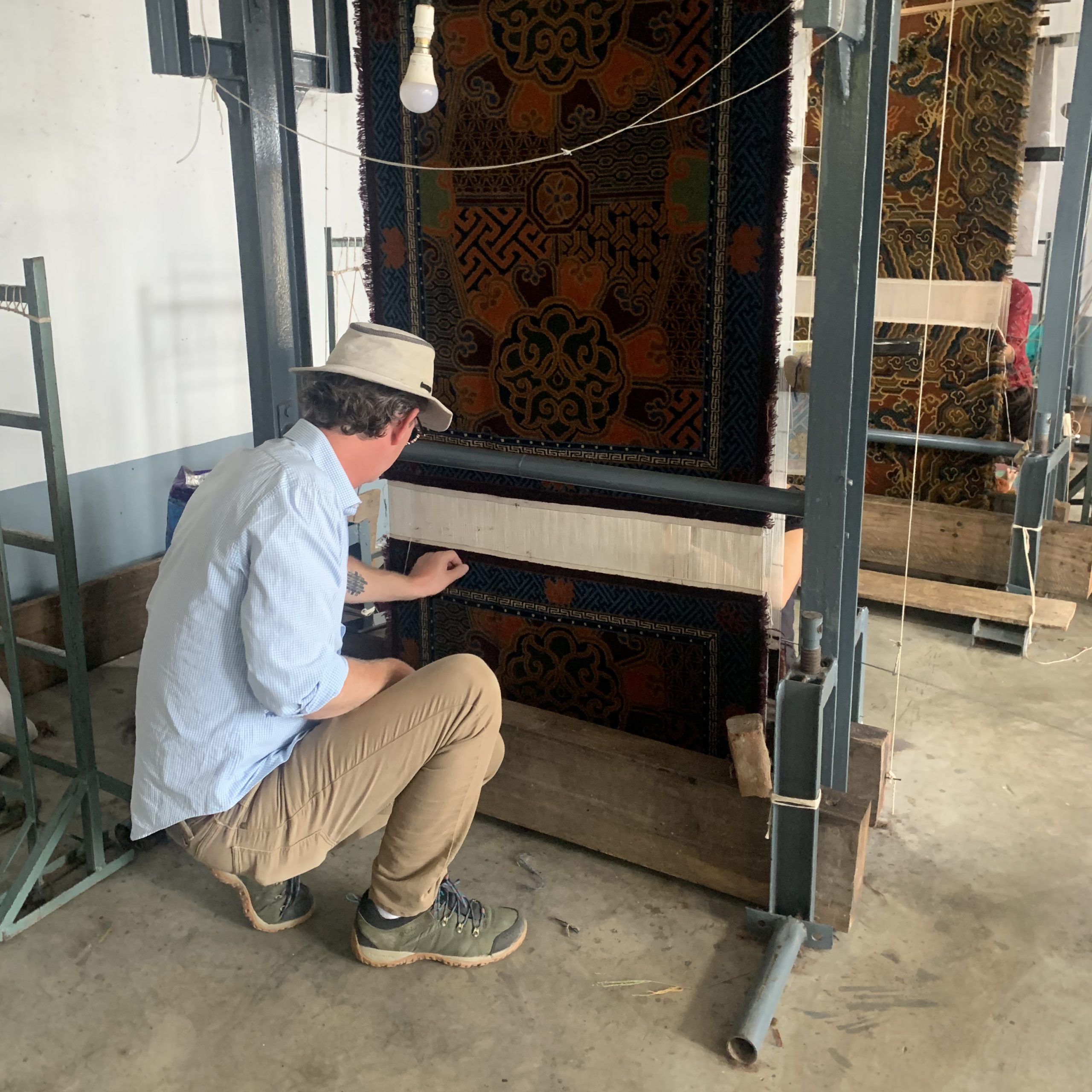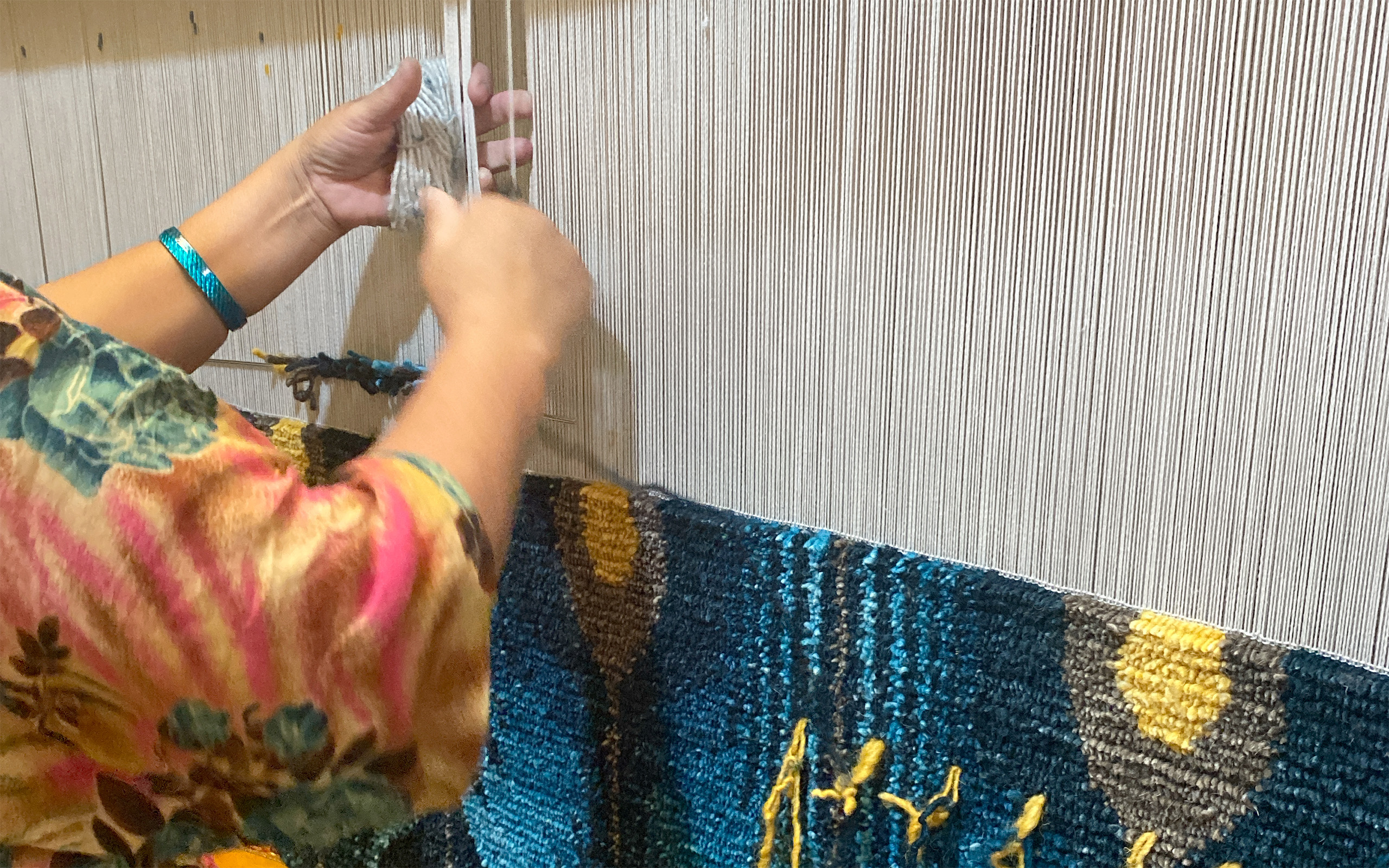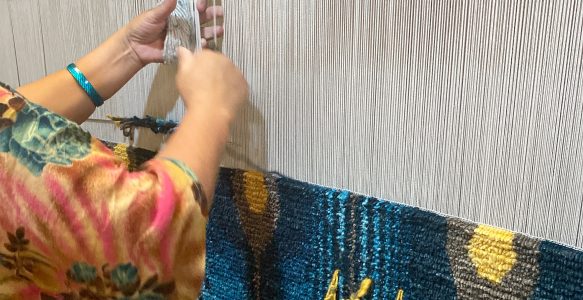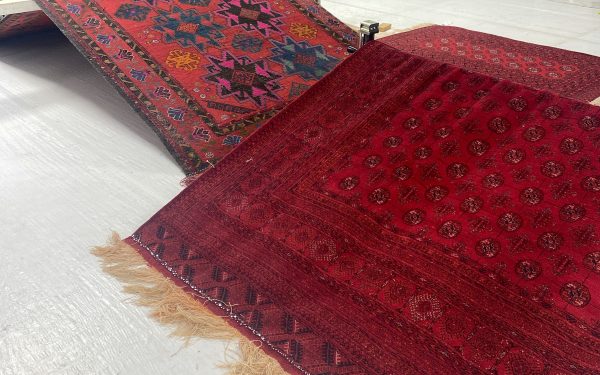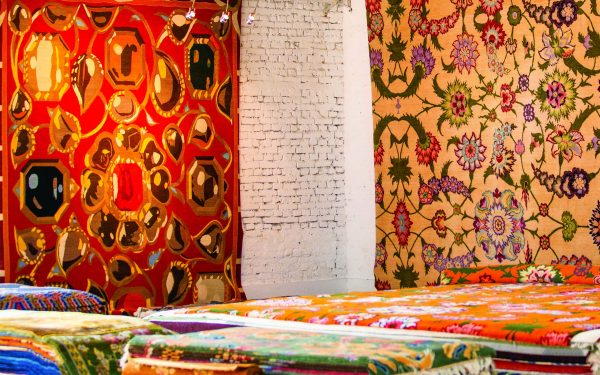These prepared remarks were originally presented to attendees of DOMOTEX during the annual rug and carpet trade fair hosted in Hannover, Germany on Thursday, 12 January 2023.
Introduction
Good afternoon Ladies and Gentlemen, my name is Michael Christie, though perhaps you know me better by my nom de plume, The Ruggist. It is under this moniker that for the past 14 years I have been promoting better and best quality handknotted rugs and carpets; most often those coming specifically from Nepal. Prior to and in many ways concurrent with this I have also been a salesman of rugs, telling since 1996 the stories – embellished, truthful, or otherwise – which tend to endear customers to the intangible cultural mystique of handknotted rugs and carpets from far off exotic lands.
This has been the all but inextricable manner in which handknotted rugs have been sold since itinerant traders first realized the potential of offering for sale textiles with motifs and designs, both apparently newfound and also modern. In those days, years, decades, if not also centuries before now, I concede that these stories provided a glimpse into other worlds all but unimaginable. Long before the ubiquity of the camera, social media, and viral videos, the marketing and advertising of rugs and carpets was dependent upon these stories to convey the artistry and craftsmanship of handknotted rugs, which must have then, and in many ways still does, captivate the layperson as they ask, almost bewildered, ‘This was all done by hand!?’
Yes, yes it was. Well okay, maybe not all of it.
For people working as weavers, we must endeavour with every sale, every advertisement, every bit of marketing to foster respect for a position which is a vestigial connection to a fundamental technology of human civilization. Without weaving, civilization as we know it would not exist. Without weavers, there is no weaving. Let us rightly elevate the position of weaver!
Michael Christie, The Ruggist
Romance has always played a role in this for the lives of those who weave were and remain not only geographically disparate from those who consume woven wares, but also socially, economically, and culturally, apart as well. People of privilege who consume luxury handknotted carpets, are unlikely to have access to the reality of the life of the person who weaves, let alone the willingness or even capacity to comprehend such existence. Much the same can be said of the reverse as well.
Over time as these stories have become more polished, perhaps more palatable, and generally propagandized, they also became entrenched in the trade as though carpet weaving, that is carpetry, was and remains this inviolable craft immune to change. A vestigial skillset fetishized as sacrosanct in order to sell rugs and carpets to modern consumers.
And this is the appeal, is it not? A connection, no matter how tenuous, to a bygone era in which honest manual labour yielded the niceties which adorn the homes of wealthy consumers.
This is not to say there is anything wrong with a little romance, because who amongst us does not love a little romance, but when our attraction to a particular product – any product, but of course specifically in this case handknotted rugs and carpets – becomes so entangled with the romance, when we conflate the past with the present, we often become blinded to the current reality of the situation.
I feel this reflects the current state of the handknotted rug and carpet trade wherein the origin stories of handknotted rugs are still used to sell modern commercially produced rugs and carpets, even though the circumstances of their creation are as different as apples and pears.
The Distinction
The title of this presentation employs an English language homophone to convey the disparity between what the circumstances were and what the current reality is, in regard to carpet production and their subsequent sales.
The artistic license we allow consumers to infer exists in all handknotted rugs and carpets did truly once exist and in that instance we should say, ’Weavers are not robots,’ n,o,t, as in they are not people who function as automatons. They are free willed textile artists empowered to create and adapt as they see fit. There are many a fine example of this type circulating amongst dealers of old and antique rugs and carpets, in private collections, auction houses, in museums, and with rare exception in pockets of new production.
On the other hand, the artistry – perhaps better said in this instance as the aesthetic – of the modern handknotted carpet is now largely specified – often individual knot by individual knot – by a carpet designer who themselves may or may not know how to weave and craft a carpet. In this instance we should say, ‘Weavers are knot robots,’ k,n,o,t, as in they are people who function as little more that a machine following instructions. They are expected to suppress any creative instincts they may have of their own in favour of dutiful adherence to a predefined weaving plan. And just as with the former example, there are likewise innumerable examples of this type for it comprises the vast majority of rug production today.
But this is not a recent development. The aesthetic demands of consumers has always needed to be met and so those marketmakers who trade in handknotted rugs and carpets have always attempted – to varying degrees of success – to mould handknotted production to the trendy desires of wealthy consumers.
For example, there was this saying in North America from about a century ago, ‘A car in every driveway and a Sarouk in every living room.’ The interesting thing about this was that while the rugs were indeed handknotted in Iran, Persia if you desire, the colours were not to the liking of American consumers. As such, a large washing, finishing, and recolouring business developed in New York City to transform those undesirable carpets into something that could be sold. This was because at the time it was all but impossible to convince weavers and production managers to employ the colours and finishing techniques producing the ‘look,’ foreign consumers wanted; a problem which still exists today in some geographies of production.
This friction between creative freedom to weave, making what one so chooses, and the decorative demands of consumers is not unique to rugs, but I highlight it here because when it comes to handknotted rugs and carpets we – as salespeople, myself included – love to talk about the weaver as artisan, and the carpet as art.
Pedantics
Perhaps you are thinking to yourself this sounds like a pedantic distinction, and in many ways it is. What difference does it matter if we expect the people who weave to follow instructions instead of expressing creativity? Realistically few modern day weavers even care to express creativity because they have learnt over time that unless a rug is aesthetically pleasing to the consumer, it simply won’t sell, which in turn means they won’t get paid. It’s safer – read as more profitable – to make something which can be sold, or better yet, in the case of made-to-order production, that which is already sold. This distinction should be self apparent to those of you in the audience who are rug buyers; you endeavour to purchase that which will sell!
So what am I trying to say here today?
In short, that we – as those who seek to keep working with new production rugs and carpets – need to adapt so that those who weave are not treated solely as mechanoids. And let me tell you why…!
Machines are coming for our jobs!
Luddites
When luddite weavers first protested the rise of automated looms during the industrial revolution, they did so out of fear of loosing their jobs, their means of employment, their means of sustaining themselves. They correctly foresaw that the owners of textile mills would be the ones to benefit from this new technology, and that they were to likely have a diminished presence, if any at all, in the new textile paradigm.
But I am not arguing against machines in any way. On a planet with a population in excess of eight (8) billion people it is simply not possible to make everything by hand, and to be frank, it is a bit insulting to our collective intelligence to ignore the maxim of ‘work smarter not harder.’
What I am saying however is that as we develop, and here on the cusp of artificial intelligence, as machines themselves develop more and more advance technologies, we as humans have to make conscientious decisions about how this technology is used and moreover, what kinds of work requires the intrinsic element of the hand that only a free willed person can bring.
In short, ‘Why make by hand what a machine can do?’
In an attempt to answer this question specifically for myself as a someone who has written about rugs, I turned to OpenAi’s ChatGPT program which has been all over the news as of late due to its uncanny ability to generate what we might call realistic prose. I asked it to write an essay about how weavers are knot robots, (k,n,o,t) in the style of film director Wes Anderson; whose work I find most endearing.
And I quote in part:
‘Weavers are often thought of as simple artisans, working with fabrics and threads to create intricate patterns and designs. But upon closer examination, it becomes clear that weavers are in fact knot (again, k,n,o,t) robots, using their impressive technical skills and precision to execute complex tasks with a level of automation that would be envied by any machine.
To the untrained eye, a weaver’s workshop may seem chaotic and disorganized, with threads of all colors and textures crisscrossing in every direction. But to a weaver, this is a meticulously organized system of knots and loops, each one serving a specific purpose in the overall design. The weaver works with a level of concentration and focus that is almost robotic, following a series of precise instructions to create the desired pattern.’
End quote.
As I stand here before you today I do not posses an impending fear of losing my job as a writer, yet just as those 19th century luddites, I do foresee a time, perhaps in the not too distant future, in which the machine may take my job. The words written by ChatGPT are not what I would describe as 100% accurate, yet in many ways the AI is also not wrong. With further development and evolution it is easy to see how this technology has the potential to be transformative.
This reminds me of the complaint I once had against Galaincha design and production software. I mistook poor use of the tool as an indictment against the tool itself. Technology is not our foe, and in fact augments this, our modern life, in ways innumerable.
As I read and reread with astonishment the words written by ChatGPT, I pondered repeatedly the impressively flowery and indeed romantic tone of the composition. And then, in what is perhaps a meta moment of clarity, I realized ChatGPT had nearly written the perfect hypothesis; it essentially solved a riddle central to the notion of handknotted rug production in the early 21st century: ‘How much hand is required in handmade?’
And I quote again:
‘…it becomes clear that weavers are in fact knot (k,n,o,t) robots, using their impressive technical skills and precision to execute complex tasks with a level of automation that would be envied by any machine.’
Expanding, I posit this is pricelessly what a modern 21st century weaver needs to be. The envy of an anthropomorphized machine. Those who weave should be able to ‘execute complex tasks’ in a manner that a machine cannot, with savoir-faire, free will, and a grasp, both literal and metaphorical, of the tactile; the intrinsic element of the hand if you will, which underwrites the intangible cultural mystique of handknotted rugs and carpets.
Said another way, make only by hand that which cannot be made by machine.
Excelsior
The anachronistic nature of handknotted rug manufacture is such that it now finds itself unsure of its place in the larger trade of all manner of rugs. Once the only way to make a pile carpet, handknotted now finds itself as the couture outlier in the multi-billion dollar international trade of soft floorcoverings. As the standard bearer of what is aesthetically fashionable, its looks, its designs, are mimicked, often duplicated across a variety of manufacturing techniques such as tufted, machine-made, printed, handloom, broadloom, and so forth.
We formerly scorned these so-called inferior rugs and carpets as mere pastiche versions of a ‘real’ rug. But as evidenced by the variety and indeed quality seen in the global marketplace and here at DOMOTEX today, this most certainly is, and most likely always was, a juvenile mocking of something that has proven the potential to transform the rug and carpet trade; I cannot see this momentum of innovation reversing course. As such, as mechanized means of rug production continue to advance, to gain in visual sophistication, to approach the look and in many cases the hand and handle of a handknotted carpet, it is the handknotted trade that must adapt to a new paradigm of weaving.
On Innovation
I count amongst my friends many, many people who bemoan what is widely perceived as a decline in handknotted production, both in terms of volume, and as I have alluded earlier, through the homogenization of design as dictated by the ad hoc committee of mass consumption and design. This has not been solely a passive decline, rather it is the handknotted rug trade’s dearth of innovation which has contributed to the current status quo. Exactly what is new – other than the visually apparent design – in handknotted rug manufacture?
In order to stand proud, those of us who love handknotted rugs and carpets must ourselves innovate in order to bring new life to this well storied trade. To do so would be to return this portion of the industry to its roots, to bring into alignment the stories and the reality of production. Its about looking with eyes wide, in order to reconcile the slowmaking nature of handknotted with this ever faster digital world.
The Past as Prologue
With past as prologue, history provides insight into periods such as now when handknotted is faced with a crisis. In the book ‘The Persian Carpet’ my friend and colleague Dr. Hadi Maktabi, writes extensively on the oft overlooked post-Safavid period of rug production.
From his thesis I extrapolate a lesson which we can apply to this time. Do not ignore the periods of perceived decline, for within these moments we have the ability to invest in artistry, innovation, and creativity, outside the bounds of convention, themselves waiting to be transcended.
Onward
To achieve this ascendency, we must reconcile the commercial concerns of trade with the decidedly non-commercial interests of pure art, finding in the compromise a solution which exudes the hallmarks required of handknotted rug and carpet production in this, the early 21st century; identity, authenticity, transparency, honest marketing, and the elusive element of the hand, all of which are critical to its future success because these are the traits I believe emerging and future demographics of rug consumers are going to want, and moreover demand.
It is said ‘The carpet does not lie,’ and so if the tangible, observable, and inherent aspects of a carpet reveal its soul, we must endeavour to craft carpets whose soul, if you will, exudes the human element of handicraft, rather than that of homogenized, mechanized and robotic machine-made mass production – literal or metaphorical.
It begins by treating those who weave as more than low paid worker cogs in a vast apparatus of consumerism. It begins by treating weavers not as knot robots, but instead as free willed humans, empowered, should they choose, to express creative freedom through the carpets they weave, individual knot by individual knot.
And that is the crux of my argument; currently and for the foreseeable future, only a human can work knot by knot, with finesse and detail that is, as my ChatGPT prompt asserts, the envy of those who cannot. And so it is that we must exploit, that is, use to our utmost competitive advantage, the intrinsic qualities of handknotted rugs in order to both set them apart from the rest of market, as well as and most importantly, to treat our fellow human with dignity and respect as more than just the essential element, the hand, of handknotted weaving.
For people working as weavers – specifically those who express a willingness, desire, and most importantly, an affinity toward creativity and design – we must encourage an environment wherein this ‘spirit of art and craft’ is fostered and nurtured.
For people working as weavers, we must engage in dialog asking what they need and want in order to feel secure in themselves.
For people working as weavers, we must endeavour with every sale, every advertisement, every bit of marketing to foster respect for a position which is a vestigial connection to a fundamental technology of human civilization. Without weaving, civilization as we know it would not exist. Without weavers, there is no weaving. Let us rightly elevate the position of weaver!
This is not in any way to say we should disregard the commercial concerns of carpet trade. On the contrary, this approach is foremost about differentiating a product so that it not only remains true to its origin stories, but also so that the hand in handknotted and handmade is not a tenuous marketing scheme, but rather a genuine reflection of the human spirit.
Before I open the floor to questions, I thank DOMOTEX for inviting me here to speak today, and I thank all of you for your time. Questions?
